Inflatable pool for summer cottages: how to choose and install?

Inflatable pools for summer cottages are in steady demand among the population and make it possible to solve the issue of arranging an artificial reservoir for the summer period. The presence of an individual bathing tank completely eliminates the risk of contracting infectious diseases, controlling the organoleptic and bacteriological indicators of the water. We will tell you how to choose an inflatable structure and install it on the site in our article.
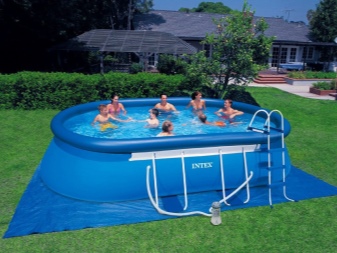
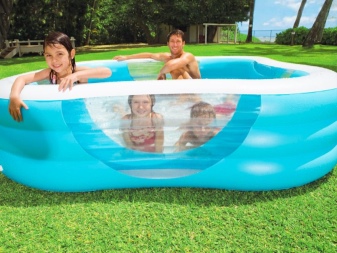
Peculiarities
An inflatable pool for a summer cottage acts as an excellent alternative to a frame tank, allowing you to get a full-fledged bathing place for little money. Such models do not require excavation and concreting, which compares favorably with pools dug in the ground. As a material for the manufacture of inflatable models, a multilayer PVC film is used, the strength of which depends on the thickness of the individual layers, as well as on their total number.
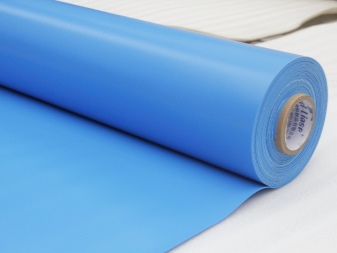
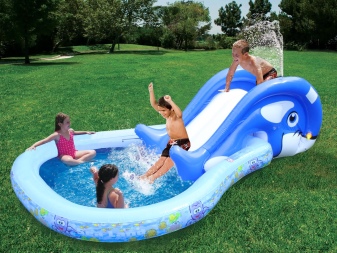
The pool walls are additionally reinforced with polyester mesh, which allows them to withstand rather high loads. Models for young children have an inflatable bottom, while larger structures are equipped with a filtration system. Products with a wall height of 91 cm and more are equipped with comfortable U-shaped ladders, and serious samples that can hold a large volume of water are equipped with devices for cleaning and washing - a special skimmer, a net, a telescopic hose, as well as a substrate under the bottom.
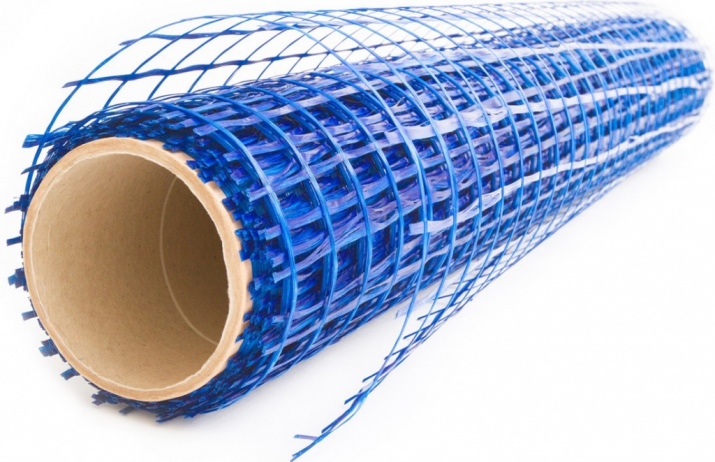
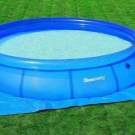
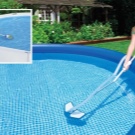

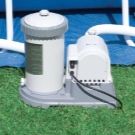
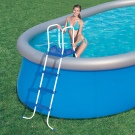
As for the method of draining the water, then most models are equipped with a drain valve that is sized for garden hoses with a diameter of 13, 19 and 25 mm. This allows water to be dumped into a drainage pit or sewer, or used for watering beds, trees and bushes. In some pools, there is no valve and a pump is used to drain the water from the tank.
Children's shallow pools are emptied by tipping over.
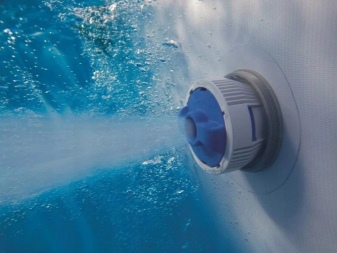
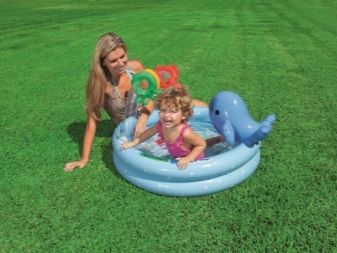
Advantages and disadvantages
The popularity of inflatable pools due to a number of positive properties of these lightweight and versatile products:
- a simple design of the tank provides easy installation and allows you to cope with this in a short time without the involvement of specialists;
- in comparison with frame and dug pools, inflatable models are relatively inexpensive, which only increases their consumer availability;
- when deflated, the pool is quite compact, which makes it easy to transport and store;
- a huge assortment with a wide variety of sizes and shapes allows you to choose a model for every taste;
- inflatable models are characterized by high mobility, as a result of which they can be drained and moved to a new place at any time.
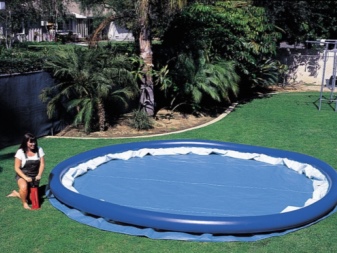
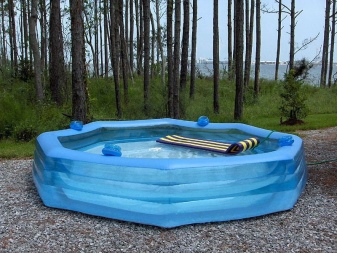

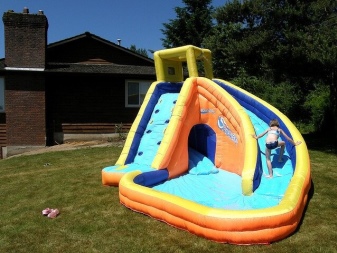
but along with a large number of obvious advantages, inflatable models still have disadvantages. These include a high probability of accidental punctures, the vulnerability of budget models to the effects of ultraviolet radiation and the need for regular pumping of the sides due to air leakage through the valves. In addition, when draining the pool, difficulties often arise in removing a large volume of liquid, which in a small suburban area is often a problem.
A significant disadvantage of inflatable structures is the impossibility of full-fledged swimming, which is due to the limited size and depth of them.
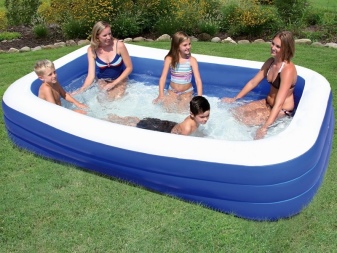
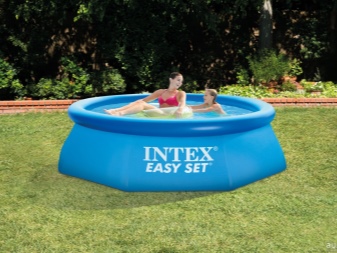
What are they?
The classification of inflatable pools for summer cottages is made according to the type of side structure and the presence of a roof. According to the first criterion, there are 2 types of models.
- Products with fully inflatable wallswhich are filled with air along their entire height.
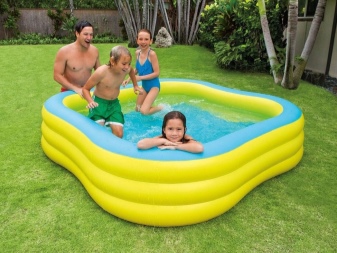
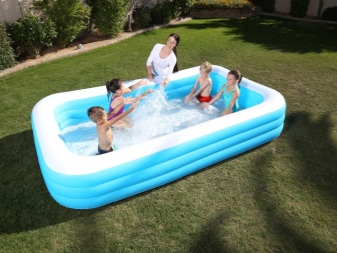
- Bulk samples, in which only the upper pipe is pumped along the perimeter of the tank. When filling such a pool with water, the inflated pipe floats up and straightens the walls of the tank, which, like the bottom, are not filled with air.
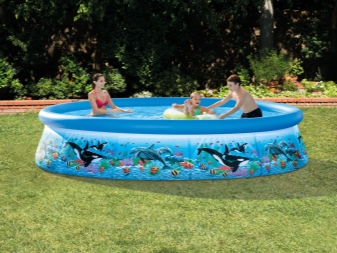
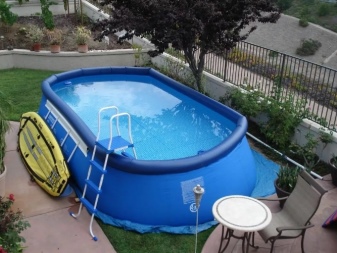
On the second basis - the presence of a roof - inflatable pools are divided into open and closed. The former do not have a roof and warm up better in the sun.
The second ones are equipped with a protective awning, and sometimes walls, and often represent real pavilions. The roof prevents debris and precipitation from entering the pool water, which makes it possible to change the water much less often. Such models often have a sliding roof, which makes it possible to remove the awning and heat the water in the sun. In addition, in the pavilion pools you can swim in windy and cool weather, and in the autumn-spring period you can use them as gazebos.

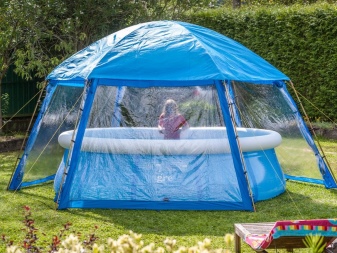
Shapes and sizes
The modern market offers inflatable pools in a wide range of sizes and shapes. The most popular are round models, in which the load of water on the walls of the tank is distributed more evenly than in rectangular or asymmetric bowls. In addition, circular pools take up less space and blend in more harmoniously with the surrounding landscape. In addition to round and rectangular shapes, there are square, oval and polygonal pieces in stores.
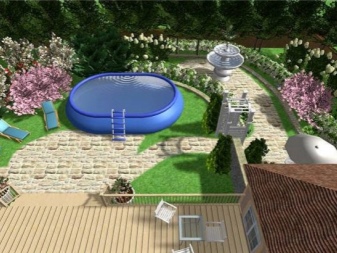
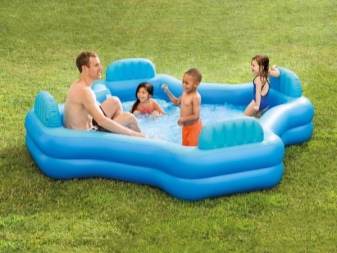
As for the sizes, the models have different heights, lengths, widths and capacities.
- So, for the smallest bathers up to one and a half years old, tanks with wall heights up to 17 cm. Such mini-reservoirs quickly and easily inflate, warm up well and merge without problems under a tree or bush.

- Models with side heights up to 50 cm intended for children from 1.5 to 3 years old. They have bright children's colors and an inflatable bottom.

- Pools with walls from 50 to 70 cm designed for children from 3 to 7 years old, often equipped with a slide, a waterfall, rings and a net for ball games.
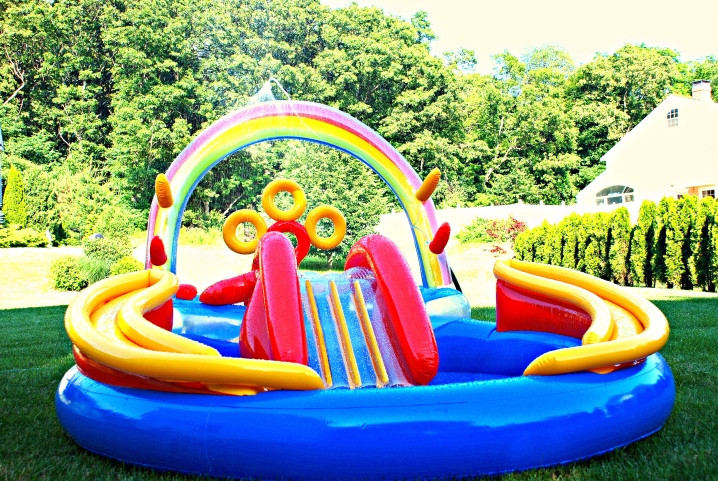
- Tanks with a height of 70 to 107 cm are equipped with a stepladder and are intended for schoolchildren from 7 to 12 years old.

- Large models with sides from 107 to 122 cm are designed for teenagers and adults. Such pools always have a ladder in the kit, often equipped with a filtration system, a pump and accessories for cleaning the bowl. The walls of such products are equipped with rubber rings, for which, with the help of ropes, the pool is tied to pegs driven into the ground. This insurance increases the overall stability of the structure and prevents tall and narrow tanks from overturning.
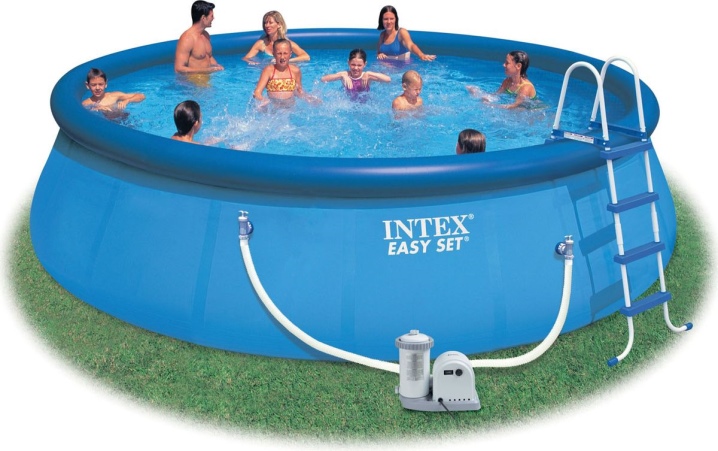
As for the volume of the pools, their capacity directly depends on the size. So, a model with sides 76 cm and a diameter of 2.5 m can hold about 2.5 tons of water, and large samples with a height of 120 cm can hold up to 23 tons.
How to choose?
When choosing an inflatable outdoor pool it is necessary to pay attention to a number of important points.
- If the pool is purchased for a child under 3 years old, it is better to buy models with an inflatable bottom. This will help prevent painful impacts on the ground if your baby accidentally falls. As for the size of the baby tank, a 1 m diameter will be enough for one child, two babies will need a 2-meter product.
- When buying a pool, you need to pay attention to the number of PVC layers and the presence of reinforcement. And you should also choose products from well-known manufacturers such as Chinese Intex, German Future Pool, French Zodiac and American Sevylor.
- You should also look at the way the water is drained. It is better to purchase models equipped with a drain valve with the ability to connect a garden hose.
- It is desirable that the product be completed with a repair kitconsisting of rubber glue and a patch.
- If the tank is planned to be used as a spa pool, then you should take a closer look at the Jacuzzi models equipped with hydromassage. To avoid clogging of the nozzles, such samples should only be operated with filtered water, which will require the purchase of a water filter.
- As for the cost of swimming pools, then a budget children's model of the Intex brand can be purchased for 1150 rubles, while an adult pool from the same manufacturer will cost 25-30 thousand. Products from German, American and French factories are two to three times more expensive than Chinese models, but they are more durable and have a longer service life.
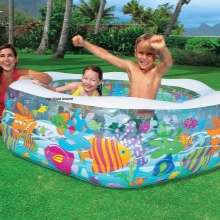
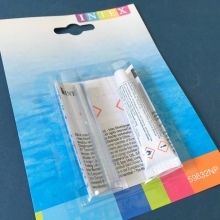
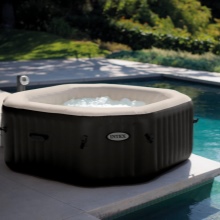
How to install correctly?
The installation of a children's inflatable pool is not difficult and can be done even by a teenager. However, the placement of an adult tank must be approached more thoroughly, carefully selecting the installation site and carrying out a number of preparatory measures.
Seat selection
When choosing a site for an inflatable pool, preference should be given to sheltered from the wind, located away from deciduous trees. The site must be absolutely level, without slopes and uneven terrain. An excellent solution would be to place the tank near the vegetable beds., where, if necessary, it will be possible to at least partially drain the water. It is advisable to choose sunny open spaces in which the water in the bowl will naturally warm up.

When choosing a place for a children's pool it should be borne in mind that the tank must be clearly visible from all points of the site, as well as from the windows of the house. This will allow you to constantly keep bathing children in sight, thereby ensuring their safety. There should be no clotheslines and electric wires above the pool, and below it there should be no underground water supply or sewerage lines.
The surface must be earthen, as asphalt and gravel areas, due to their roughness, are not suitable for the installation of inflatable structures. In addition, the chosen place must be "clean": the installation of an inflatable pool on soil that has been treated with chemicals is prohibited.
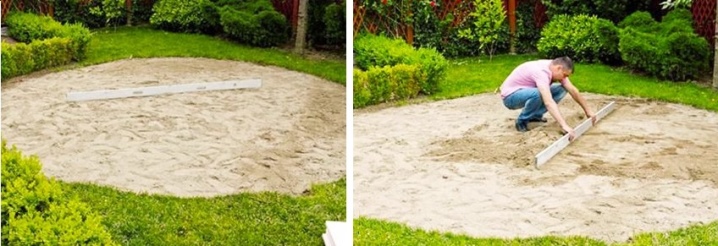
What to bet on?
After the place has been determined, it is necessary to clear it of stones and debris, and then start arranging the substrate. A tarpaulin or PVC film, folded 3-4 times, is used as a bedding. Such a gasket will not only serve to protect the bottom of the pool from damage, but also act as a heat-insulating layer that does not allow water to quickly cool from the ground.
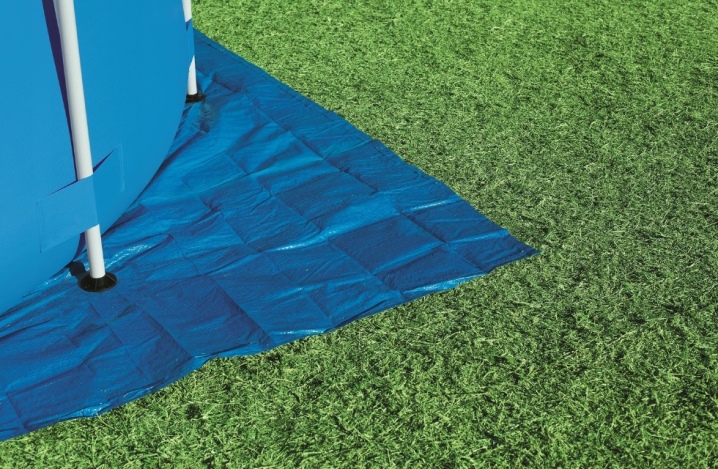
Installation rules
After preparing the site for installation, the pool is carefully transferred to the installation site and carefully leveled. Then the sides and, if necessary, the bottom of the tank are inflated with a hand or foot pump. It is not recommended to use a compressor for inflating poolsas this can lead to pumping and cause seam divergence.

The final stage in starting up the pool is filling it with water. For pediatric samples, it is recommended to use filtered drinking water. For adult models, river water is also suitable, which it is desirable to disinfect with special preparations. However, after such treatment, it will no longer be possible to drain it into the beds and it will be necessary to take care of an alternative method of draining the liquid. The chemically treated fluid can be changed once a month; ordinary tap water requires replacement every two to three days.
In addition, daily water needs to be topped up to the required level, since under the sun it actively evaporates or splashes out when swimming.

Care features
In order for the inflatable pool to serve as long as possible, it must be properly cared for.
- Every day with a special net insects, fallen leaves and other mechanical debris should be removed from the water surface.
- It is recommended to cover the tank with foil at night., and in the morning, with the appearance of the first rays of the sun, open for warming up.
- When a leak is detected it is necessary to drain the water, blow out the chambers and wipe the damaged area dry. Then you should cut off the patch of the desired size, apply glue and seal the hole. You can use the pool after 12-24 hours (depending on the brand of glue).
- At the end of the swimming season the pool is drained, washed thoroughly with soapy water, rinsed with a hose and laid out in a sunny place to dry. Then the product is compactly rolled up and stored in a case.
- Store inflatable pool need in a dry place at room temperature away from heating appliances and open flames. It is strictly forbidden to leave the product in an unheated room: low temperatures negatively affect PVC and cause its fragility.
With careful use and proper storage, an inflatable pool can last 5 years or more.
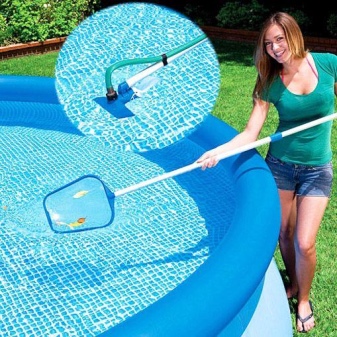

For information on how to choose inflatable pools for children, see the next video.



































































The comment was sent successfully.